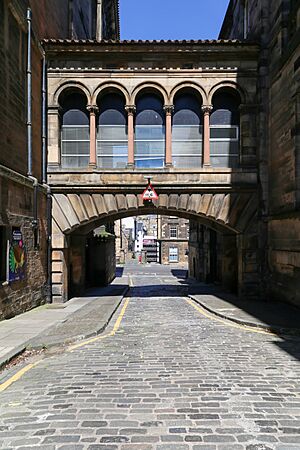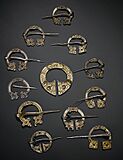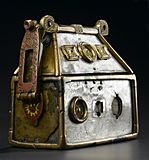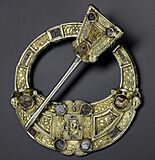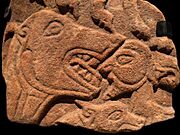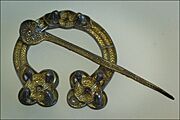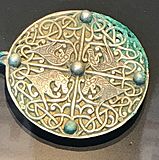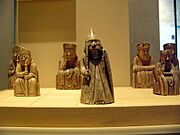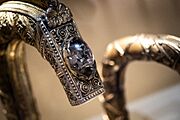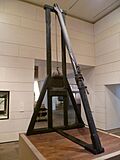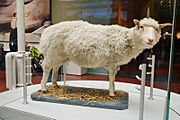National Museum of Scotland facts for kids
Quick facts for kids National Museum of Scotland |
|
|---|---|
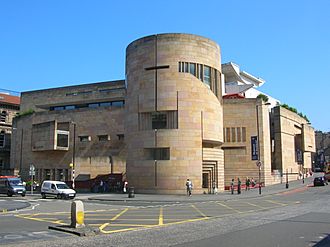
Scottish History and Archaeology department, opened in 1998 with collections from the National Museum of Antiquities of Scotland
|
|
| General information | |
| Architectural style | Victorian Venetian Renaissance and modern |
| Town or city | Edinburgh |
| Country | Scotland |
| Coordinates | 55°56′49″N 3°11′24″W / 55.94694°N 3.19000°W |
| Construction started | 1861 |
| Completed | 1866 and 1998 |
| Inaugurated | 1866 |
| Renovated | 2011 |
| Design and construction | |
| Architect | Benson & Forsyth |
| Structural engineer | Anthony Hunt Associates |
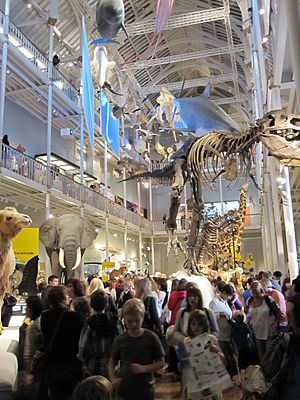
The National Museum of Scotland in Edinburgh, Scotland, is a super cool place to explore! It's a museum that tells the story of Scotland's history and amazing culture.
This big museum was created in 2006. It brought together two older museums that stood right next to each other. One was the Museum of Scotland, which focused on Scottish history and ancient objects. The other was the Royal Scottish Museum, which had collections from all over the world. These included science, technology, natural history, and different cultures.
The two buildings are connected and stand on Chambers Street in central Edinburgh. The museum is part of National Museums Scotland, and the best part is that entry is free!
The two parts of the museum look very different. The Museum of Scotland is in a modern building that opened in 1998. The other building, which used to be the Royal Museum, is much older. It started being built in 1861 and opened some parts in 1866. It has a beautiful Victorian style with a huge central hall made of cast iron. This older building had a big makeover and reopened in 2011.
The National Museum has collections from the old National Museum of Antiquities of Scotland. You can see ancient Scottish finds and medieval items. But it also has objects from all over the world! These include geology (rocks and earth), archaeology (old human history), natural history (animals and plants), science, technology, art, and world cultures. When the museum reopened in 2011, it showed 8,000 objects, with many of them being displayed for the first time.
One of the most famous exhibits is Dolly the sheep. She was the first mammal successfully cloned from an adult cell! Other cool things to see include Ancient Egyptian exhibits, a fancy suit worn by Sir Elton John, and a giant moving sculpture called the Millennium Clock. A fun Scottish invention that kids often enjoy is the Scottish Maiden. It was an early beheading machine, similar to the French guillotine.
In 2019, over 2.2 million people visited the museum. This made it Scotland's most popular place to visit that year!
Contents
Discovering the Museum's Past
How the Museum Started
The museum's story began a long time ago, in 1697. A man named Robert Sibbald gave his collection of natural history items to the University of Edinburgh. This collection was one of the first museums in the UK. People loved it, and one writer in 1737 called it a "fine Musæum" with rare items.
Later, a mineralogist named Robert Jameson took charge in 1804. He made the collection much bigger, buying items and getting travelers to send back their finds. In 1812, it was even called the "Royal Museum of the University." The museum grew so much that it needed a new building, which opened in 1820. Famous people like Charles Darwin studied there and learned from its curator.
By 1852, the collections were too big for the space. So, it was suggested that the government take over the natural history items to create a new National Museum. This idea became real shortly after Jameson passed away in 1854.
Building the Chambers Street Museum
The government decided to create a new museum that would combine the university's collection with a new institution. This new place would teach the public about business and industrial arts. In 1854, they bought the land for the new building.
The museum was first called the Industrial Museum of Scotland. Its goal was to show off economic products from animals, plants, and industries. George Wilson was the first director, but he sadly passed away in 1859. Thomas Croxen Archer took over in 1860.
The design for the building was done by Captain Francis Fowke and architect Robert Matheson. Construction started in 1861. On October 23, 1861, Prince Albert himself laid the foundation stone for the museum. This was one of his last public appearances.
The Edinburgh Museum of Science and Art Opens
In 1864, the museum changed its name to the Edinburgh Museum of Science and Art. It had two main parts: Natural History and Industrial Arts. The natural history collection moved from the university in 1865–1866.
Prince Alfred officially opened the first part of the museum on May 19, 1866. Visitors could see the east wing and some of the Great Hall. Displays included models of architecture, engineering, and even lighthouses. The natural history collection was in a large hall, now called Animal World.
Over time, the museum grew and changed. In 1873, it officially separated from the university. The central part of the museum, including the rest of the Great Hall, was finished in 1874. The west wing was completed in 1888.
Becoming the Royal Scottish Museum
In 1904, the museum was renamed the Royal Scottish Museum. This was a big change! Electricity was added, replacing the old gas lights. This also allowed for the first interactive displays, like push-button models of a marine steam engine and a steam locomotive.
A Fun April Fool's Prank
The Royal Scottish Museum once played a great April Fool's Day joke! In 1975, they displayed a made-up bird called the "Bare-fronted Hoodwink." This bird was supposedly so shy that it always flew away before anyone could get a good look. The exhibit even had blurry photos of birds flying away. To make it super convincing, a taxidermist created a fake bird using parts from real birds, like a carrion crow's head and a plover's body. The "bare front" was made of wax!
Merging into the National Museum
In 1985, the museum was renamed the Royal Museum of Scotland. It became part of a new group called National Museums Scotland. Another museum, the Museum of Antiquities, moved into a new building next to the Royal Museum in 1998. This new building was called the Museum of Scotland.
Because having two similar names caused confusion for visitors, the two museums officially merged in 2006. They became one big museum: the National Museum of Scotland. The old Chambers Street building closed for a big renovation in 2008 and reopened in July 2011.
In August 2023, the museum started preparing to return a special Ni'isjoohl totem pole to the Nisga'a people in Canada. This 36-foot pole was carved in 1855 and came to Scotland in 1929 after being taken from the Nisga'a.
Amazing Architecture
The National Museum of Scotland is made up of two very different but connected buildings.
The Royal Scottish Museum Building
This older building started construction in 1861. The first parts opened in 1866, and the whole original design was finished in 1888. It was designed by Captain Francis Fowke and architect Robert Matheson. The outside looks like a fancy Venetian Renaissance palace. But inside, the main hall, called the Grand Gallery, is bright and airy. It was inspired by The Crystal Palace, a famous glass and iron building.
Many additions were made to the back of the building, especially in the 1930s. A big renovation finished in 2011 created a new, vaulted entrance hall at street level. This involved lowering the floor and adding modern lifts and escalators.
The Museum of Scotland Building
This newer building was designed by Benson & Forsyth. It has cool, geometric shapes and reminds people of Scottish brochs (ancient towers) and castles. It's covered in golden Moray sandstone. One of the architects called this stone "the oldest exhibit in the building," linking it to Scottish geology. There's even a roof garden with Scottish plants and amazing views of the city! This building was nominated for a famous architecture award in 1999.
What You Can See: The Collections
The museum's collections are incredible! In the newer building, you can explore Scottish history in order, from ancient times to more recent periods. The older Victorian building, which reopened in 2011, has four main areas. These cover natural history, world cultures (like the South Pacific, East Asia, and Ancient Egypt), European art and design, and science & technology.
The Grand Gallery has many large objects. A special display called the "Window on the World" rises four stories high. It holds over 800 objects that show how diverse the museum's collections are. Near the Grand Gallery, the "Discoveries" gallery highlights "remarkable Scots." These are people famous for inventions, explorations, and adventures.
Here are some of the amazing things you can find:
- An Assyrian relief showing King Ashurnasirpal II.
- The Monymusk Reliquary, an ancient Scottish container.
- The St Ninian's Isle Treasure, a collection of Pictish silver.
- 11 of the famous Lewis chessmen (the rest are in the British Museum).
- Beautiful Celtic brooches, like the Hunterston Brooch.
- Pictish stones with ancient carvings.
- The Cramond Lioness and other items from Roman times in Scotland.
- The Maiden, an early form of guillotine.
- Prince Charlie's Targe (a shield) and backsword.
- The stuffed body of Dolly the sheep.
- Sculptures by Sir Eduardo Paolozzi.
- A 16th-century BC Egyptian coffin and mummy, known as the Qurna Queen.
- The Galloway Hoard, a treasure of Viking-age objects.
- The Darien chest, used for money during the Darien scheme.
- A silver belt given to a farmer by the Earl of Lauderdale.
Gallery
-
Hacksilver artifacts from Norrie's Law hoard, 6th century
-
Brooches from St Ninian's Isle Treasure, Pictish horde, mid-8th century
-
Chape from the St Ninian's Isle Treasure, c. 750–825 AD
-
Brooch from the Galloway Hoard, 9th century
-
Some of the 11 Lewis chessmen, 12th century
-
Taxidermy of Dolly the sheep
-
Inchkeith lighthouse lens and drive mechanism
See also
 In Spanish: Museo Nacional de Escocia para niños
In Spanish: Museo Nacional de Escocia para niños


